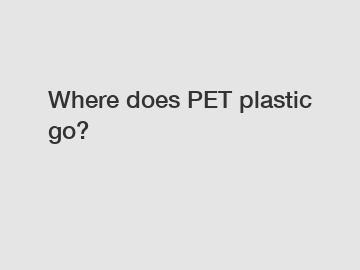Where does PET plastic go?
Where does PET plastic go?
As awareness of environmental issues continues to grow, more and more people are becoming concerned about the fate of plastic waste. One common type of plastic regularly used in everyday items is known as PET, or polyethylene terephthalate. But where does PET plastic go after it has fulfilled its purpose? In this article, we will explore the journey of PET plastic waste and discuss the various destinations it may end up in.
1. Recycling: One of the most effective ways to manage PET plastic waste is through recycling. PET is a highly recyclable material, and many countries have established recycling programs to collect and process it. The process typically involves sorting and cleaning the plastic bottles or containers, followed by shredding and melting them to form small pellets that can be used to make new PET products. Recycling PET plastic helps conserve energy, reduce greenhouse gas emissions, and preserve valuable resources.

2. Manufacturing: Another destination for PET plastic waste is the manufacturing industry. The recycled PET pellets mentioned earlier can be used to create a wide range of products. These can include new PET bottles, polyester fiber for clothing or carpets, as well as various packaging materials. By using recycled PET in manufacturing processes, companies can reduce their reliance on virgin plastic and contribute to a more sustainable future.
3. Waste-to-energy plants: In some cases, PET plastic waste may be sent to waste-to-energy plants. These facilities specialize in converting non-recyclable waste into energy through processes like incineration or gasification. While this option can help generate electricity or heat, it is generally considered less favorable than recycling. The combustion of plastics releases greenhouse gases and other pollutants into the atmosphere, contributing to air pollution. Therefore, waste-to-energy plants should be seen as a last resort for PET plastic that cannot be recycled.
4. Landfills: Unfortunately, a significant amount of PET plastic still ends up in landfills. Improper disposal or lack of recycling infrastructure could be reasons for this. When PET plastic waste is sent to landfills, it can take hundreds of years to decompose fully. As it breaks down, it can release harmful chemicals into the soil and water, posing a threat to the environment and wildlife. To mitigate this, it is crucial to expand recycling programs, raise awareness about proper waste management, and encourage individuals and businesses to actively participate in recycling efforts.
In conclusion, PET plastic waste can take various paths after its initial use. Recycling is the ideal solution, as it allows for the creation of new products while conserving resources and reducing environmental impact. By supporting recycling initiatives, individuals and businesses can contribute to a more sustainable future. However, it is also essential to address the challenges associated with improper disposal and limited recycling infrastructure, as this could result in PET plastic ending up in landfills or waste-to-energy plants. Ultimately, the responsible management of PET plastic waste is a collective responsibility, and together, we can make a significant difference in preserving our planet for future generations. So, where does PET plastic go? It's up to us to ensure it heads towards a greener and more sustainable destination: recycling.
Are you interested in learning more about pet bottle crushing machine, pet flakes hot washer, plastic bottle crusher for home? Contact us today to secure an expert consultation!
212
0
0

Comments
All Comments (0)